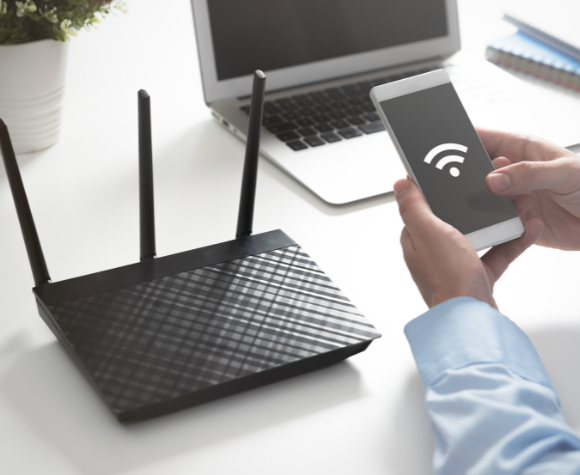Understanding Wireless Device Strength
 HTC field technicians and tech support team members often throw out terms like “wireless interference” and “channel congestion“. It can all be a little confusing and it’s easy to forget that not everyone shares our enthusiastic obsession with all things tech. So, let’s take a moment to really dive into wireless devices, their capabilities and their downfalls.
HTC field technicians and tech support team members often throw out terms like “wireless interference” and “channel congestion“. It can all be a little confusing and it’s easy to forget that not everyone shares our enthusiastic obsession with all things tech. So, let’s take a moment to really dive into wireless devices, their capabilities and their downfalls.
Many homes and businesses contain what we in the internet biz like to call Wi-Fi haters. They’re often totally natural and unassuming items but they can be a major Wi-Fi buzzkill.
Here’s a quick breakdown of construction materials that may negatively impact your wireless signal strength:

Sometimes we hear reports from customers about a totally normal wireless connection and signal strength that suddenly drops out of nowhere for short bursts of time. This is when we ask about the environment and try to see if we can pin the issue on frequency interference which is a fancy way of saying “your microwave makes a mean burrito, but it’s killing your signal.” Ordinary household items like microwaves, cordless phones, wireless speakers, fluorescent lights, baby monitors and garage door openers can have a big impact on your experience. This is because these types of gadgets often operate on a 2.4Ghz spectrum.
Those numbers and letters sound familiar, right?
Your HTC router operates on the same frequency with the 2.4Ghz network. Good news though – your router also comes with a 5Ghz network which helps newer compatible devices skip the burrito bailout. Our routers come standard with a 2.4Ghz wireless band, a 5Ghz wireless band and has four Ethernet ports to skip right over any wireless dilemmas. If your router seems unnecessarily close to any of these household items, let us know, we can help. Additionally, you might consider doing a little detective work when you’re in the market for new gadgets. Some baby monitors operate on a 900MHz frequency and newer cordless phone systems may use a 1.9Ghz frequency rather than the common 2.4Ghz frequency.
Other less common barriers include hearing aids, power lines, railway tracks, power stations, and are you ready for this one… your hand. Some reports show that when positioned in exactly the wrong spot, your grip can affect Wi-Fi performance and a simple position change can sometimes be an easy fix.
The distance your wireless devices travel from the location of your router will also have an impact. We believe our router and its dual networks provide an exceptional signal and range capacity in average-sized homes but throw in a few environmental issues, a baby monitor, and several hundred extra square feet, and you might have a problem.
Device capability plays a role in your Wi-Fi experience too.
We live in a connected world where wireless is king and thanks to heavy investments by tech companies, speed capabilities change every three to five years. So, when you run a speed test on your 10-year-old laptop from college, it will definitely not get the same results as your brand-new smartphone. It’s exciting to see technology evolve so rapidly but it’s important to remember that devices just a few years ago were not built to run at the speeds HTC provides today.
Translation?
You’re on HTC’s 500Mbps internet service but your trusty Acer laptop with the missing number lock button was only built to go as fast a 50-60 Mbps and it will never reach 300 Mbps wirelessly because it just doesn’t have the ability.
To get a little more specific when it comes to device capability, many modern devices use a technology called MIMO (multiple input – multiple output). To understand this technology, think of your router like a water hydrant which has up to four hose connections. The more hoses you connect, the more water (think data) you’ll get. A large portion of mobile devices only have 1 (1×1) or 2 (2×2) MIMO connections.
So even though our HTC router will push out 1 Gbps speed, most mobile devices aren’t able to handle that much data and reflect gigabit-speed based on their MIMO antennae. Most laptops will have a 2×2 or 3×3 MIMO antennae, and in the 3×3 case it can provide up to 1.3 Gbps of data to your device. So, if you’re looking for a new device that will give you maximum data, search out a machine with 3×3 MIMO antennae. You can quickly find this information by doing a browser search for the device you’re interested in + MIMO. You’ll often find the information in the technical specifications online and the friendly salesperson at your local electronics store is sure to have the details too.
The HTC Connection
Although our HTC network and equipment are pushing out some of the fastest available internet speeds on the planet, there are a variety of factors that could encroach on your otherwise flawless internet experience. Many tech aficionados will tell you, the best way to cover your wireless bases is to ensure your router is 802.11AC capable with dual-band frequency (2.4 and 5Ghz) and it’s no coincidence that our included router follows suit. As technology advances, devices will be better able to keep up with our speeds, but for now we’ll keep focusing on the future to make sure we’re ahead of the curve.
Visit this resource for tips to optimize your wi-fi signal.
